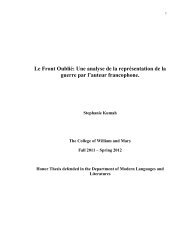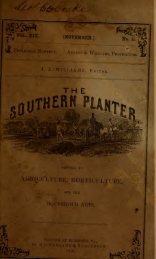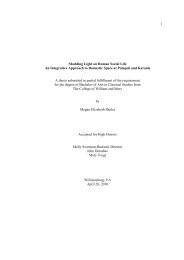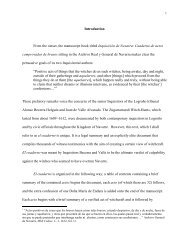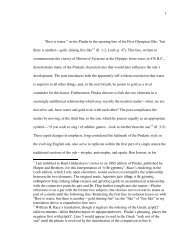Southern planter : devoted to agriculture, horticulture, and the ...
Southern planter : devoted to agriculture, horticulture, and the ...
Southern planter : devoted to agriculture, horticulture, and the ...
Create successful ePaper yourself
Turn your PDF publications into a flip-book with our unique Google optimized e-Paper software.
416 THE SOUTHERN PLANTER,<br />
it passes off by exhalation, or evaporation<br />
of <strong>the</strong> leaves. The amount of water daily<br />
evaporated by large-leaved plants, like <strong>the</strong><br />
cabbage, pumpkin, grape, <strong>and</strong> sunflower,<br />
especially when under <strong>the</strong> influence of a<br />
warm, dry atmosphere, aided by <strong>the</strong> direct<br />
rays of <strong>the</strong> sun, is much greater than<br />
some persons may be aware of. Hales<br />
made an experiment with a sunflower three<br />
feet high, inclosed in a vessel, wiiich he<br />
kept for fifteen days ;<br />
<strong>and</strong> inferred from it,<br />
that <strong>the</strong> weight of <strong>the</strong> fluid daily exhaled<br />
by <strong>the</strong> plant was twenty ounces. Mr.<br />
Everett in his address at Buffalo, stated<br />
<strong>the</strong>re had grown seven millions of counted<br />
leaves on a single tree." If Hale's three<br />
feet sunflower, with its dozen leaves, exhaled<br />
twenty ounces of M'ater per diem,<br />
how many pounds will daily be evaporated<br />
by <strong>the</strong> " seven millions of leaves on a<br />
single tree?" Can any of our juvenile<br />
readers figure it out for us ?<br />
From <strong>the</strong> foregoing it will be seen that<br />
one of <strong>the</strong> important functions of <strong>the</strong><br />
leaves of a plant, is <strong>to</strong> carry off <strong>the</strong> surplus<br />
water—<strong>to</strong> boil down, as it was, <strong>the</strong><br />
crude, dilute sap, holding in solution <strong>the</strong><br />
various salts or mineral ingredients that<br />
make up " part <strong>and</strong> parcel " of all plants<br />
<strong>and</strong> thus, by a greater concentration of <strong>the</strong><br />
mineral ingredients held in solution by <strong>the</strong><br />
sap, <strong>the</strong>y are more fully prepared <strong>to</strong> enter<br />
in<strong>to</strong> <strong>the</strong> various chemical combinations<br />
with carbon, <strong>and</strong> <strong>the</strong> o<strong>the</strong>r organic constituents<br />
whicli make up <strong>the</strong> entire <strong>and</strong> per-<br />
fect plant in all its varied parts.<br />
But <strong>the</strong> leaves of plants, besides <strong>the</strong>ir<br />
exhaling power, have ano<strong>the</strong>r important<br />
function <strong>to</strong> perform in <strong>the</strong> phenomena of<br />
vegetable life. It is through <strong>the</strong> agency<br />
of <strong>the</strong> leaves that most of <strong>the</strong> woody <strong>and</strong><br />
o<strong>the</strong>r carbonaceous structures of plants are<br />
derived. Carbon in one form or ano<strong>the</strong>r,<br />
is <strong>the</strong> leading combustible substance in all<br />
fuel generally used— in wood, coal, charcoal,<br />
oil, rezin, pitch, &c. While burning,<br />
<strong>the</strong> carbon unites with <strong>the</strong> oxygen of <strong>the</strong><br />
atmosphere, resulting in carbonic acid<br />
<strong>and</strong> every cord of wood burned, res<strong>to</strong>res<br />
<strong>to</strong> <strong>the</strong> atmosphere just carbon enough <strong>to</strong><br />
grow ano<strong>the</strong>r cord. By passing in<strong>to</strong> <strong>the</strong><br />
air, <strong>the</strong> carbon is not lost; <strong>the</strong>re is no such<br />
word as lost in <strong>the</strong> whole vocabulary of<br />
nature. Carbonic acid oras, thouo^h much<br />
heavier than common air, is by <strong>the</strong> great<br />
law of gaseous diffusion, equally difl:used<br />
through <strong>the</strong> atmosphere, composing abou^<br />
l-2500th part of it.<br />
When sugar or salt is mixed with water,<br />
it dissolves <strong>and</strong> becomes invisible—when<br />
carbon is burned, it is in fact dissolved in<br />
oxygen gas, <strong>and</strong> <strong>the</strong> carbon becomes invisible.<br />
By evaporating <strong>the</strong> water holding<br />
<strong>the</strong> sugar or salt in solution, we again obtain<br />
<strong>the</strong> sugar <strong>and</strong> salt in precisely <strong>the</strong> state<br />
<strong>the</strong>y were in before solution. But we<br />
cannot, by any known chemical or o<strong>the</strong>r<br />
process, obtain carbon from carbonic acid<br />
in <strong>the</strong> form of wood, oil or starch. To do<br />
this requires <strong>the</strong> more efficient agency of<br />
vegetable chemistry.<br />
In <strong>the</strong> economy of nature, it has been<br />
so arranged that <strong>the</strong> healthy leaves of<br />
plants in sun light, can <strong>and</strong> do inhale from<br />
<strong>the</strong> air with which <strong>the</strong>y are surrounded,<br />
<strong>the</strong> carbonic acid that seems so sparsely<br />
mingled with it—<strong>to</strong> do this <strong>the</strong> leaves<br />
have been endowed with very nice discriminating<br />
powers ; <strong>and</strong> fur<strong>the</strong>r, <strong>the</strong>y have<br />
<strong>the</strong> power of decomposing <strong>the</strong> carbonic<br />
acid, that is, separating <strong>the</strong> oxygen from<br />
<strong>the</strong> carbon, which <strong>the</strong>y retain, <strong>and</strong> returning<br />
<strong>to</strong> <strong>the</strong> atmosphere <strong>the</strong> oxygen in a<br />
pure form.<br />
When a fresh leaf is examined by a<br />
microscope, its whole surface is seen <strong>to</strong> be<br />
covered with minute pores on each side of<br />
<strong>the</strong> leaf; each of <strong>the</strong>se j)ores is a species<br />
of mouth, intended <strong>to</strong> receive food or <strong>to</strong><br />
give off something that <strong>the</strong> plant no longer<br />
requires. A high magnifying power discovers<br />
more than 100,000 openings in a<br />
square inch upon <strong>the</strong> surface of some<br />
leaves ; o<strong>the</strong>rs have not more than 600<br />
700. Analogous <strong>to</strong> this is <strong>the</strong> skin of animals,<br />
which is perforated with a thous<strong>and</strong><br />
pores in <strong>the</strong> length of an inch, through<br />
which <strong>the</strong> insensible perspiration passes.<br />
It is no more marvellous that <strong>the</strong> leaf of<br />
a plant can take in <strong>the</strong> carbonic acid of<br />
<strong>the</strong> air, separate it, <strong>and</strong> retain <strong>the</strong> carbon<br />
<strong>and</strong> reject <strong>the</strong> oxygen,* than it is that a<br />
grown up boy can take in<strong>to</strong> his mouth a<br />
ripe peach <strong>and</strong> separate <strong>the</strong> s<strong>to</strong>ne <strong>and</strong> pulp,<br />
<strong>and</strong> swallow <strong>the</strong> pulp <strong>and</strong> spit out <strong>the</strong><br />
s<strong>to</strong>ne. From whence did <strong>the</strong> boy derive<br />
his ability <strong>to</strong> pass <strong>the</strong> pulp of <strong>the</strong> peach<br />
through <strong>the</strong> gullet in<strong>to</strong> <strong>the</strong> s<strong>to</strong>mach ? From<br />
<strong>the</strong> same Being: that endowed <strong>the</strong> leaf<br />
* In 2'2 lbs. of carbonic acid, <strong>the</strong>re is 6 lbs. of<br />
carbon <strong>and</strong> 18 lbs. of oxvgeii.






